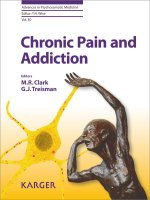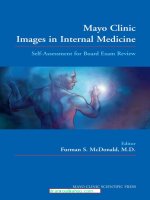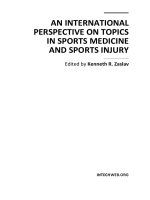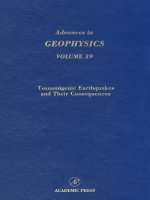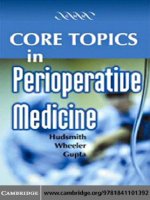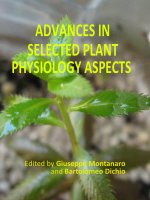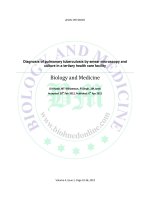ADVANCES IN REGENERATIVE MEDICINE doc
Bạn đang xem bản rút gọn của tài liệu. Xem và tải ngay bản đầy đủ của tài liệu tại đây (17.53 MB, 416 trang )
ADVANCES IN
REGENERATIVE MEDICINE
Edited by Sabine Wislet-Gendebien
Advances in Regenerative Medicine
Edited by Sabine Wislet-Gendebien
Published by InTech
Janeza Trdine 9, 51000 Rijeka, Croatia
Copyright © 2011 InTech
All chapters are Open Access distributed under the Creative Commons Attribution 3.0
license, which allows users to download, copy and build upon published articles even for
commercial purposes, as long as the author and publisher are properly credited, which
ensures maximum dissemination and a wider impact of our publications. After this work
has been published by InTech, authors have the right to republish it, in whole or part, in
any publication of which they are the author, and to make other personal use of the
work. Any republication, referencing or personal use of the work must explicitly identify
the original source.
As for readers, this license allows users to download, copy and build upon published
chapters even for commercial purposes, as long as the author and publisher are properly
credited, which ensures maximum dissemination and a wider impact of our publications.
Notice
Statements and opinions expressed in the chapters are these of the individual contributors
and not necessarily those of the editors or publisher. No responsibility is accepted for the
accuracy of information contained in the published chapters. The publisher assumes no
responsibility for any damage or injury to persons or property arising out of the use of any
materials, instructions, methods or ideas contained in the book.
Publishing Process Manager Romana Vukelic
Technical Editor Teodora Smiljanic
Cover Designer Jan Hyrat
Image Copyright Aija Abele, 2011. Used under license from Shutterstock.com
First published November, 2011
Printed in Croatia
A free online edition of this book is available at www.intechopen.com
Additional hard copies can be obtained from
Advances in Regenerative Medicine, Edited by Sabine Wislet-Gendebien
p. cm.
ISBN 978-953-307-732-1
free online editions of InTech
Books and Journals can be found at
www.intechopen.com
Contents
Preface IX
Part 1 Stem Cells 1
Chapter 1 Neural Crest Stem Cells from Adult Bone Marrow:
A New Source for Cell Replacement Therapy? 3
Aneta Glejzer, Virginie Neirinckx,
Bernard Rogister and Sabine Wislet-Gendebien
Chapter 2 Regenerative Medicine for Cerebral Infarction 19
Masahiro Kameda and Isao Date
Chapter 3 Human Umbilical Cord Blood
Stem Cells Rescue Ischemic Tissues 35
Dong-Hyuk Park, Jeong-Hyun Lee, David J. Eve,
Cesario V. Borlongan, Paul R. Sanberg,
Yong-Gu Chung
and Tai-Hyoung Cho
Chapter 4 Therapeutic Approaches in Regenerative Medicine
of Cardiovascular Diseases: From Bench to Bedside 61
Antonia Aránega, Milán Bustamante, Juan Antonio Marchal,
Macarena Perán, Elena López, Pablo Álvarez,
Fernando Rodríguez-Serrano and Esmeralda Carrillo
Chapter 5 Cytoprotection and Preconditioning
for Stem Cell Therapy 89
S. Y. Lim, R. J. Dilley and G. J. Dusting
Chapter 6 Degeneration and Regeneration
in the Vertebrate Retina 119
Gabriele Colozza, André Mazabraud and Muriel Perron
Chapter 7 A Strategy Using Pluripotent Stem Cell-Derived
Hepatocytes for Stem Cell-Based Therapies 145
Daihachiro Tomotsune, Fumi Sato, Susumu Yoshie,
Sakiko Shirasawa, Tadayuki Yokoyama, Yoshiya Kanoh,
Hinako Ichikawa, Akimi Mogi, Fengming Yue and Katsunori Sasaki
VI Contents
Chapter 8 Amniotic Fluid Progenitor Cells and
Their Use in Regenerative Medicine 165
Stefano Da Sacco, Roger E. De Filippo and Laura Perin
Part 2 Cell Communicators 179
Chapter 9 Inflammation-Angiogenesis Cross-Talk and Endothelial
Progenitor Cells: A Crucial Axis in Regenerating Vessels 181
Michele M. Ciulla, Paola Nicolini, Gianluca L. Perrucci,
Chiara Benfenati and Fabio Magrini
Chapter 10 Cellular Stress Responses 215
Irina Milisav
Part 3 Tissue Engineering 233
Chapter 11 Tissue Engineering of Tubular
and Solid Organs: An Industry Perspective 235
Joydeep Basu and John W. Ludlow
Chapter 12 Self-Organization as a Tool in
Mammalian Tissue Engineering 261
Jamie A. Davies
Chapter 13 Scaffolds for Tissue Engineering
Via Thermally Induced Phase Separation 275
Carlos A. Martínez-Pérez, Imelda Olivas-Armendariz,
Javier S. Castro-Carmona and Perla E. García-Casillas
Chapter 14 Nano-Doped Matrices for Tissue Regeneration 295
Leonardo Ricotti, Gianni Ciofani,
Virgilio Mattoli and Arianna Menciassi
Chapter 15 The Role of Platelet Gel in Regenerative Medicine 319
Primož Rožman, Danijela Semenič and Dragica Maja Smrke
Chapter 16 Regenerative Orthopedics 349
Christopher J. Centeno and Stephen J. Faulkner
Chapter 17 Cell-Biomaterial Interactions Reproducing a Niche 363
Silvia Scaglione, Paolo Giannoni and Rodolfo Quarto
Chapter 18 Influence of Angiogenesis on Osteogenesis 389
Susanne Jung and Johannes Kleinheinz
Preface
In order to better introduce this book, it is important to define regenerative medicine.
This field is built through a combination of multiple elements including living cells,
matrix to support the living cells (i.e. a scaffold), and cell communicators (or signaling
systems) to stimulate the cells, and their surrounding environment to grow and
develop into new tissue or organ. Indeed, regenerative medicine is an emerging
multidisciplinary field involving biology, medicine, and engineering that is likely to
revolutionize the ways we improve the health and quality of life for millions of people
worldwide by restoring, maintaining, or enhancing tissue and organ function.
Even if the origins of regenerative medicine can be found in Greek mythology, as
attested by the story of Prometheus, the Greek god whose immortal liver was feasted
on day after day by Zeus' eagle; many challenges persist in order to successfully
regenerate lost cells, tissues or organs and rebuild all connections and functions. In
this book, we will cover a few aspects of regenerative medicine highlighting major
advances and remaining challenges in cellular therapy (including cell communicators)
and tissue/organ engineering.
Cell replacement therapy
The types of cells that are used are dependent on the type of tissue that needs to be
repaired. Several cells have been suggested as suitable for cellular therapies: i.e.
embryonic stem cells (ES), induced pluripotent stem cells (iPS); somatic stem cells
from fetal or adult tissues. The potential use of fetal tissue or differentiated embryonic
stem cells from allogenic sources suffer limitations due to tissue availability, ethical
issues or safety concerns. On the contrary, adult somatic stem cells can be used in
autologus graft procedure, avoiding patient’s immunosuppression. In this book,
several chapters will discuss stem cell applications in regenerative medicine focusing
on several organs or tissues like brain, heart, liver or retina.
Cell communicators
The circulatory system is involved in the transport of a wide variety of biological
molecules and cells and can be considered as the body's basic communication system.
Cell communicators act as a signaling system, which stimulates the cells into action.
X Preface
In some cases those communicators could lead cells to integrate damage tissues and
rebuild lost connections, however, some signals could also induce cellular stress
responses conducting to cell death. Few of those aspects will be directly addressed in
this book.
Tissue engineering or …where biology meets engineering.
All cells within tissues are separated and interlinked by a matrix or structure. The
consistency of the matrix may vary from liquid, as in blood; to semi-solid, as in
cartilage; to solid, as in bone. Tissue engineers either implant cells into a matrix or
create the proper conditions for the living cells to build their own three dimensional
matrix. Such a matrix provides the structure that supports the cells and creates the
physiological environment for them to interact within the host tissue. The success or
failure of an implant material in the body depends on a complex interaction between a
synthetic ‘foreign body’ and the ‘host tissue’, which involves not only biological, but
also mechanical, physical and chemical mediated factors. The latest advances in tissue
engineering will be discussed in this book underlying many challenges that remain
pending in this field.
Finally, I would like to conclude this preface by expressing my deepest gratitude to all
the authors who contributed to the realization of this book.
Sabine Wislet-Gendebien, PhD
GIGA Neurosciences
University of Liège,
Belgium
Part 1
Stem Cells
1
Neural Crest Stem Cells from
Adult Bone Marrow: A New Source
for Cell Replacement Therapy?
Aneta Glejzer
1
, Virginie Neirinckx
1
,
Bernard Rogister
1,2,3
and Sabine Wislet-Gendebien
1
1
GIGA-Neurosciences, University of Liège,
2
GIGA-Development, Stem cells and Regeneative Medicine, University of Liège,
3
Neurology Department, CHU,
Belgium
1. Introduction
Neurodegenerative disease is a generic term used for a wide range of acute and chronic
conditions whose etiology is unknown such as Parkinson's disease, Huntington's disease,
amyotrophic lateral sclerosis (ALS), Alzheimer's disease, but also now for other neurological
diseases whose etiology is better known but which are also concerned by a chronic lost of
neurons and glial cells such as multiple sclerosis (MS), stroke, and spinal cord injury.
Although the adult brain contains small numbers of stem cells in restricted areas, the central
nervous system exhibits limited capacity of regenerating lost tissue. Therefore, cell
replacement therapies of lesioned brain have provided the basis for the development of
potentially powerful new therapeutic strategies for a broad spectrum of human neurological
diseases. However, the paucity of suitable cell types for cell replacement therapy in patients
suffering from neurological disorders has hampered the development of this promising
therapeutic approach.
Stem cells are classically defined as cells that have the ability to renew themselves
continuously and possess pluripotent or multipotent ability to differentiate into many cell
types. Besides the germ stem cells devoted to give rise to ovocytes or spermatozoïdes, those
cells can be classified in three subgroups: embryonic stem cells (ES), induced pluripotent
stem cells (iPS) and somatic stem cells (Figure 1). ES cells are derived from the inner mass of
blastocyst and are considered as pluripotent stem cells as these cells can give rise to various
mature cells from the three germ layers. iPS cells are also pluripotent stem cells, however,
those cells derived from adult somatic cells such as skin fibroblasts are genetically modified
by introduction of four embryogenesis-related genes (Takahashi et al., 2007; Park et al.,
2008). Finally, tissue-specific stem cells known as somatic or adult stem cells are more
restricted stem cells (multipotent stem cells) and are isolated from various fetal or adult
tissues (i.e. hematopoietic stem cells, bone marrow mesenchymal stem cells, adipose tissue-
derived stem cells, amniotic fluid stem cells, neural stem cells, etc.; Reviewed by Kim and de
Vellis, 2009).
Advances in Regenerative Medicine
4
Fig. 1. Stem cell type and origin. Besides germ stem cells, three group of stem cells can be
defined according to their differentiating abilities: A. pluripotent embryonic stem cells (ES),
B. induced pluripotent stem cells (iPS) and C. multipotent fetal or adult somatic stem cells
(Figure adapted from Sigma-Aldrich).
Neural Crest Stem Cells from Adult Bone Marrow: A New Source for Cell Replacement Therapy?
5
In recent years, neurons and glial cells have been successfully generated from stem cells
such as embryonic stem cells (Patani et al., 2010), iPS (Swistowski et al., 2010), mesenchymal
stem cells (MSC) (Wislet-Gendebien et al., 2005), and adult neural stem cells (reviewed by
Ming et Song, 2011), and extensive efforts by investigators to develop stem cell-based brain
transplantation therapies have been carried out. Over the last decade, convincing evidence
has emerged of the capability of various stem cell populations to induce regeneration in
animal models of Parkinson’s disease (PD), Huntington’s disease, Alzheimer’s disease (AD),
multiple sclerosis or cerebral ischemia (Reviewed by Gögel et al., 2011). Some of the studies
have already been carried out to clinical trials. In example, in the case of Parkinson’s disease,
transplantation of fetal ventral mesencephalon tissue directly into the brains of PD patients has
been done in a few centers with varying results (Kordower et al., 2008; Li et al., 2008 ; Mendez et al.,
2008) and it appeared that using fetal ventral mesencephalon tissue raised numerous
problems from ethical issues to heterogeneity and relative scarcity of tissue (reviewed by
Wakeman et al., 2011) suggesting that other stem cells (like adult somatic stem cells) may be
more suitable for such a therapy. Likewise, ES cells have also been grafted in patients with
injured spinal cord, as USA Federal Regulators have cleared the way for the first human
trials of human ES-cell research, authorizing researchers to test whether those cells are safe
or not (Schwarz et al., 2010). It is still to early to know the effect of ES cells on patient
recovery; however, several concerns have been previously raised on animal models as ES
cells induced teratocarcimas and some exploratory clinical trials are confirming the animal
studies (reviewed by Solter, 2006).
In this chapter, we will review our results concerning identification and characterization of
neural crest stem cells (NCSC) in adult bone marrow as a potential source for cellular
therapy in neurological disorders. We will also discuss what are the main questions that
remain pending concerning the use of those cells in cellular therapy protocols for
neurological disorders.
2. Somatic stem cells isolated from adult bone marrow
The post-natal bone marrow has traditionally been seen as an organ composed of two main
systems rooted in distinct lineages—the hematopoietic tissue and the associated supporting
stroma. The evidence pointing to a putative stem cell upstream of the diverse lineages and
cell phenotypes comprising the bone marrow stromal system has made marrow the only
known organ in which two separate and distinct stem cells and dependent tissue systems
not only coexist but functionally cooperate, defining hematopoietic stem cells (HSC) and
mesenchymal stem cells (MSC) (reviewed by Bianco et al., 2001).
MSC were first isolated from the bone marrow (BM-MSC) stem cell niche. More recently,
extensive research has revealed that cells with morphological and functional
characteristics similar to BM-MSC can be identified in a large number of organs or tissues
including adipose tissue and peripheral blood. Despite having different origins, these
MSC populations maintain cell biological properties typically associated with stem cells.
These include continuous cell cycle progression for self-renewal and the potential to
differentiate into highly specialized cell types of the mesodermal phenotype including
chondroblast, osteoblast, and adipocyte lineages. Interestingly, BM-MSC have also been
reported to be inducible via the ectodermal or endodermal germline, demonstrating the
expression of neuron-like factors insulin production or hepatic lineage-associated genes
respectively. In addition to these general stem cell properties, the International Society for
Cellular Therapy proposed a more specific panel of markers for the characterization of
Advances in Regenerative Medicine
6
MSC. Due to the failure to identify a certain unique MSC cell-surface molecule, a set of
minimal criteria for MSC was recommended, which includes the capability of adherence
to plastic surfaces and the expression of the cell surface markers CD44, CD73, CD90, and
CD105 with a concomitant absence of CD14, CD19, CD34, CD45, and HLA-DR expression
(Reviewed by Hilfiker et al., 2011).
Originally analyzed because of their critical role in the formation of the hematopoietic
microenvironment (HME), bone marrow stromal cells became interesting because of their
surprising ability to differentiate into mature neural cell types. More recently, a third stem
cell group has been identified as originating from the neural crest, which could explain the
capacity of stromal stem cells to differentiate into functional neurons.
2.1 Neural phenotypic plasticity of adult bone marrow stromal cells
Several years ago, we demonstrated that a fraction of bone marrow stromal cells were able
to differentiate into functional neurons. Those specific cells were characterized as nestin-
positive mesenchymal stem cells (Wislet-Gendebien, 2003-2005). Electrophysiological
analyses using the whole-cell patch-clamp technique revealed that adult rat bone marrow
stromal cells (Wislet-Gendebien et al., 2005a and 2005b) were able to differentiate into
excitable neuron-like cells when they were co-cultivated with mouse cerebellar granule
neurons. First, we demonstrated that those cells express several neuronal markers (NeuN
and Beta-III-tubulin ; Figure 2), an axonal marker (neurofilament protein recognized by the
Fig. 2. Neuronal marker expressed by bone marrow stromal cells. Bone marrow stromal cells
were co-cultivated for 5 days with GFP-positive cerebellar granule neurons (green).
Immunofluorescence labeling showed that beta-III tubulin recognize by Tuj1 antibodies
(red) was expressed by about 20% of bone marrow stromal cells (GFP-negative or non-green
cells) (Wislet-Gendebien et al., 2005).
Neural Crest Stem Cells from Adult Bone Marrow: A New Source for Cell Replacement Therapy?
7
monoclonal antibody, SMI31) and a dendritic marker (MAP2ab). Electrophysiological
recordings of these nestin-positive bone marrow-derived neuron-like cells (BMDN) were
performed and three maturation stages were observed (Table 1). At 4–6 days of co-culture,
BMDN showed some neurotransmitter responsiveness (GABA, glycine, serotonin and
glutamate) and voltage-gated K
+
currents inhibited by TEA (tetraethylammonium).
However, those cells did not express functional sodium voltage-gated channels and have a
low membrane potential (Vrest) (-37.6° 3mV, n = 61). During the second week of co-
culture, BMDN started to display Na
+
currents reversely inhibitsed by TTX (tetrodotoxin)
and became able to fire single spike of action potential. In those older co-cultures, the Vrest
reaches a more negative value, which was closer to the value usually measured in neurons
(7–9 days, -50.3 2mV, n = 76 and 10–15 days, -56.7 2.3mV, n = 97).
As only nestin-positive bone marrow stromal cells were able to differentiate into functional
neurons, we performed several proteomic and transcriptomic comparisons that pointed out
several characteristics like ErbB3 and Sox10 over-expression in nestin-positive MSC,
suggesting that these cells could actually be neural-crest derived cells (reviewed by Wislet-
Gendebien et al., 2008). Few months later, Nogoshi et al. (2008) confirmed the presence of
neural crest derived cells in adult bone marrow.
Table 1. Maturation steps of bone marrow derived neuron-like cells
2.2 Characterization of neural crest stem cells from adult bone marrow
2.2.1 Neural crest stem cell origin
In early vertebrate development, the neural crest is specified in the embryonic ectoderm at
the boundary of the neural plate and the ectoderm. Once specified, the neural crest cells
undergo a process of epithelium to mesenchyme transition (EMT) that will confer them the
ability to migrate. The EMT involves different molecular and cellular machineries and
implies deep changes in cell morphology and in the type of cell surface adhesion and
recognition molecules. When the EMT is complete, they delaminate from the neural
Advances in Regenerative Medicine
8
folds/neural tube and migrate along characteristic pathways to differentiate into a wide
variety of derivates (Figure 3; reviewed by Kalcheim, 2000).
Fig. 3. Neurulation and neural crest migration. As neurulation proceeds, the neural plate
rolls up and the neural plate border becomes the neural folds. Near the time of neural tube
closure (depending on the species), the neural crest cells go through an epithelial to
mesenchymal transition (EMT) and delaminate from the neural folds or dorsal neural tube
and migrate along defined pathways.
In 2000, Jiang et al. developed a two-component genetic system based on Cre/lox
recombination to label indelibly the entire mouse neural crest population at the time of its
formation, and to detect it at any time thereafter. Briefly, the fate of neural crest cells was
Neural Crest Stem Cells from Adult Bone Marrow: A New Source for Cell Replacement Therapy?
9
mapped in vivo by mating ROSA26 Cre reporter (R26R) mice, which express β-
galactosidase upon Cre-mediated recombination, with mice expressing Cre recombinase
under the control of the Wnt1 promoter. In Wnt1-Cre/R26R double transgenic mice,
virtually all neural crest stem cells express β-galactosidase. Using this transgenic model,
Sieber-Blum and Grim (2004) demonstrated the presence of pluripotent neural crest stem
cells in adult follicle hairs, Wong et al. (2006) demonstrated the presence of neural crest
cells in the mouse adult skin and Nagoshi et al. (2008) confirmed the presence of NCSC in
adult bone marrow (Table 2).
Table 2. Presence of neural crest derived cells in adult tissues.
2.2.2 Self-renewal ability and multipotency of adult bone marrow NCSC
To consider NCSC from adult bone marrow as a potential source for cellular therapy
protocol, a better characterization of those cells was mandatory. In our study, we first
address the self-renewal ability, as first characteristic of stemness. Indeed, we demonstrated
that NCSC were able to grow as spheres, which is one of the main hallmarks of immature
neural cells and proliferate from a single cell culture (clonal culture). We then addressed the
multipotency and verify if those NCSC clones were able to differentiate into multiple
mature cell types. Indeed, we observed that NCSC were able to differentiate into adipocytes,
melanocytes, smooth muscles, osteocytes, neurons and astrocytes (Figure 4, Glejzer et al.,
2011).
2.2.3 Maintenance and proliferation of adult bone marrow NCSC
Before using NCSC from adult bone marrow, we have to face some limiting factors like the
fact that NCSC are a minority population (less than 1%) in adult bone marrow. As Wnt1 and
BMP2 factors were described to help for maintenance and proliferation of NCSC isolated
from embryo (Sommer, 2006), we tested those two factors, on adult NCSC isolated from
adult bone marrow. Interestingly, we demonstrated that Wnt1 and BMP2 were able to
increase the number of NCSC present in bone marrow stromal cell culture, up to four times
within 2 passages (Glejzer et al., 2011) reaching 20 % of NCSC.
Advances in Regenerative Medicine
10
Fig. 4. Multipotency of adult bone marrow NCSC. NCSC clones were subjected to
differentiating protocols and were shown to be able to differentiate into adipocytes (Oil Red
O labeling), melanocytes (L-DOPA labeling), smooth muscles (SMA-labeling) and
Osteocytes (alkaline phosphatase activity). Moreover, when co-cultured with cerebellar
granule neurons, we were able to differentiate NCSC clones into neurons (betaIII-tubulin
labeling by Tuj1 monoclonal antibody) or astrocytes (GFAP labeling).
Neural Crest Stem Cells from Adult Bone Marrow: A New Source for Cell Replacement Therapy?
11
3. In vivo characterization of neural crest stem cells and/or bone marrow
stromal cells in neurological disorder mice models
3.1 Spinal stroke
Among others, the spinal cord is the collection of fibers that runs from or to the brain
through the spine, carrying signals from or to the brain to or from the rest of the body.
Those signals control a person’s muscles and enable the person to feel various sensations.
The main consequence of injuries to the spinal cord is the interference with those signals.
Those injuries are characterized as “complete” or “incomplete”: if the injured person loses
all sensation and all ability to control the muscles below the point of the injury, the injury is
said “complete”; in the case of an “incomplete” injury, the victim retains some ability to feel
sensations or control movement below the injured area.
Main goals in spinal cord repair include reconnecting brain and lower spinal cord, building
new circuits, re-myelination of demyelinated axons, providing trophic support, and
bridging the gap of the lesion (Reviewed by Enzmann et al., 2006). Overcoming myelin-
associated and/or glial-scar-associated growth inhibition are experimental approaches that
have been most successfully studied in in vivo experiments. Further issues concern gray
matter reconstitution and protecting neurons and glia from secondary death (Reviewed by
Enzmann et al., 2006).
In this purpose, neural crest stem cells isolated from the bulge of hair follicle have been
grafted in rat model of spinal cord lesion (reviewed by Sieber-Blum 2010). Those cells
survived, integrated and intermingled with host neurites in the lesioned spinal cord. NCSC
were non-migratory and did not proliferate or form tumors. Significant subsets of grafted
cells expressed the neuron-specific beta-III tubulin, the GABAergic marker glutamate
decarboxylase 67 (GAD67), the oligodendrocyte markers RIP or myelin basic protein (MBP)
(Sieber-Blum et al., 2006). More interestingly, functional improvement was shown by two
independent approaches, spinal somatosensory evoked potentials (SpSEP) and the Semmes-
Weinstein touch test (Hu et al., 2010). The strength of NSCS was fully characterized as they
can exert a combination of pertinent functions in the contused spinal cord, including cell
replacement, neuroprotection, angiogenesis and modulation of scar formation. However,
those results have never been confirmed with human NCSC, which should be the next
promising step.
Similar studies were previously performed with bone marrow stromal cells. Indeed, several
researches reported the anti-proliferative, anti-inflammatory and anti-apoptotic features of
bone marrow stromal cells (reviewed by Uccelli et al., 2011). Indeed, Zeng et al. (2011)
demonstrated that BMSC seeded in a three dimensions gelatin sponge scaffold and
transplanted in a transected rat spinal cord resulted in attenuation of inflammation,
promotion of angiogenesis and reduction of cavity formation. Those BMSC were isolated
from 10 weeks old rats and passaged 3 to 6 times. Likewise, Xu et al. (2010) demonstrated
that a co-culture of Schwann cell with BMSC had greater effects on injured spinal cord
recovery than untreated BMSC. Indeed, analyses of chemokine and cytokine expression
revealed that BMSC/Schwann cell co-cultures produced far less MCP-1 and IL-6 than BMSC
or Schwann cells cultured alone. Transplanted BMSC may thus improve recovery in spinal
cord injured mice through immunosuppressive effects that can be enhanced by a Schwann
cell co-culturing step. These results indicate that the temporary presence of BMSC in the
Advances in Regenerative Medicine
12
injured cord is sufficient to alter the cascade of pathological events that normally occurs
after spinal cord injury and therefore, generating a microenvironment which favours an
improved recovery. In this study, BMSC were isolated from adult mice and used after 4
passages.
3.2 Multiple sclerosis
Multiple sclerosis (MS) is a common neurological disease and a major cause of disability,
particularly affecting young adults. It is characterized by patches of damage occurring
throughout the brain and spinal cord with loss of myelin sheaths accompanied by loss of
cells that make myelin (oligodendrocytes) (reviewed by Scolding, 2011). In addition, we
now know that there is damage to neurons and their axons too, and that this occurs both
within these discrete patches and in tissue between them. The cause of MS remains
unknown, but an autoimmune reaction against oligodendrocytes and myelin is generally
assumed to play a major role and early acute MS lesions almost invariably show prominent
inflammation. Efforts to develop cell therapy of nervous system lesion in MS have long been
directed towards directly implanting cells capable of replacing lost oligodendrocytes and
regenerating myelin sheaths.
To our knowledge, no experiment has been performed to characterize the effect of neural
crest stem cells on the improvement of Multiple Sclerosis disease; however, several data can
be collected concerning the positive effect of Schwann cells (derived from NCSC) and of
bone marrow stromal cells.
As previously described in injured spinal cord, bone marrow stromal cells have been
characterized on their anti-proliferative, anti-inflammatory and anti-apoptotic features.
These properties have been exploited in the effective treatment of experimental autoimmune
encephalomyelitis (EAE), an animal model of multiple sclerosis where the inhibition of the
autoimmune response resulted in a significant neuroprotection (reviewed by Uccelli et al.,
2011). Based on recent experimental data, a number of clinical trials have been designed for
the intravenous (IV) and/or intrathecal (ITH) administration of BMSCs in MS patients
(Grigoriadis et al., 2011).
3.3 Parkinson disease
Parkinson's disease (PD) is a chronic, progressive neurodegenerative disorder
characterized by a continuous and selective loss of dopaminergic neurons in the substantia
nigra pars compacta with a subsequent reduction of dopamine release mainly in the
striatum. This ongoing loss of nigral dopaminergic neurons leads to clinical diagnosis
mainly due to occurrence of motor symptoms such as rigidity, tremor and bradykinesia,
which result from a reduction of about 70% of striatal dopamine (reviewed by Meyer et
al., 2010).
Levy et al. (2008) analyzed the effect of differentiated human BMSC onto dopaminergic
precursor on hemi-Parkinsonian rats, after transplantation into striatum. This graft resulted
in improvement of rat behavioral deficits quantified by apomorphine-induced rotational
behavior. The transplanted induced-neuronal cells proved to be of superior benefit
compared with the transplantation of naive BMSC. Immunohistochemical analysis of
grafted brains revealed that abundant induced cells survived the grafting procedure and
some of these cells displayed dopaminergic traits.
Neural Crest Stem Cells from Adult Bone Marrow: A New Source for Cell Replacement Therapy?
13
Similarly, Zhang et al. (2008) isolated and characterized MSCs from Parkinson's disease
(PD) patients and compared them with MSCs derived from normal adult bone marrow.
These authors show that PD-derived MSCs are similar to normal MSCs in phenotype,
morphology, and differentiation capacity. Moreover, PD-derived MSCs are able of
differentiating into neurons in a specific medium with up to 30% having the characteristics
of dopamine cells. At last, PD-derived MSCs could inhibit T-lymphocyte proliferation
induced by mitogens. These findings indicate that MSCs derived from PD patients' bone
marrow could be a promising cell type for cellular therapy and somatic gene therapy
applications.
3.4 Huntington disease
Huntington disease (HD) is an autosomal dominant genetic disorder caused by the
expansion of polyglutamine encoded by CAG repeats in Exon 1 of the IT15 gene encoding
for Huntingtin (Htt). The polyglutamine repeat length determines the age of onset and the
overall level of function, but not the severity of the disease (Vassos et al., 2007). Although
the exact mechanism underlying HD disease progression remains uncertain, the hallmark of
this disease is a gross atrophy of the striatum and cortex and a decrease of GABAergic
neurons (DiFiglia et al., 1997).
One strategy for HD therapy is to enhance neurogenesis, which has been studied by the
administration of Stem/progenitor cells, including BMSC. Several studies (reviewed by
Snyder et al., 2010) showed that BMSC promote repair of the CNS by creating a more
favorable environment for neuroprotection and regeneration through the secretion of
various cytokines and chemokines. Moreover, Snyder et al. (2010) demonstrated that BMSC
injected into the dentate gyrus of HD mice model increased neurogenesis and decreased
atrophy of the striatum.
3.5 Alzheimer disease
Alzheimer's disease (AD) is the most common form of dementia, affecting more than 18
million people worldwide. With increased life expectancy, this number is expected to rise in
the future. AD is characterized by progressive memory deficits, cognitive impairment, and
personality changes associated with the degeneration of multiple neuronal types and
pathologically by the presence of neuritic or amyloid plaques and neurofibrillary tangles
(Reviewed by Selko, 2001). Amyloid β-peptide (Aβ) appears to play a key pathogenic role in
AD, and studies have connected Aβ plaques with the formation of intercellular tau tangles,
another neurotoxic feature of AD (Reviewed by Mattson, 2004). Currently, no treatment is
available to cure or prevent the neuronal cell death that results in inevitable decline in AD
patients.
The innate immune system is the vital first line of defense against a wide range of pathogens
and tissue injuries, triggering inflammation through activation of microglia and
macrophages. Many studies have shown that microglia are attracted to and surround senile
plaques both in human AD samples and in rodent transgenic models that develop AD-
related disease (Simard et al., 2006). In this context, Lee and al. (2010) demonstrated that
treated APP/PS1 mice (mouse model of AD) with BM-MSCs promoted microglial
activation, rescued cognitive impairment, and reduced Aβ and tau pathology in the mouse
brain.

